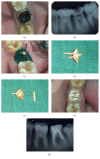Management of Grossly Decayed Mandibular Molar with Different Designs of Split Cast Post and Core
- PMID: 27144038
- PMCID: PMC4842040
- DOI: 10.1155/2016/2976941
Management of Grossly Decayed Mandibular Molar with Different Designs of Split Cast Post and Core
Abstract
Mandibular molar with extensive loss of tooth structure, especially where no cavity wall is remaining, and insertion of posts in both the roots appear necessary so as to achieve proper retention for the core material. A single unit metal casting with two posts, one in the mesial root and the other in the distal divergent root, is difficult to fabricate due to difference in the path of insertion of the two posts. Multisection post and core or single cast post and core with auxiliary post can be an effective design to manage grossly decayed mandibular molars.
Figures



Similar articles
-
Microcomputer tomography measurement of minimum residual dentin thickness in mandibular first molars after virtual fiber post placement.J Prosthet Dent. 2020 Mar;123(3):506-513. doi: 10.1016/j.prosdent.2018.11.018. Epub 2019 Jun 18. J Prosthet Dent. 2020. PMID: 31227234
-
Influence of post system and remaining coronal tooth tissue on biomechanical behaviour of root filled molar teeth.Int Endod J. 2011 May;44(5):386-94. doi: 10.1111/j.1365-2591.2010.01807.x. Epub 2011 Feb 12. Int Endod J. 2011. PMID: 21314691
-
In vitro comparison of endodontic posts in structurally compromised roots of maxillary incisors.SADJ. 2011 Jun;66(5):220-3. SADJ. 2011. PMID: 23193862 Clinical Trial.
-
Mandibular first and second molar. The variability of roots and root canal system.Minerva Stomatol. 1998 Sep;47(9):409-16. Minerva Stomatol. 1998. PMID: 9835748 Review.
-
Mandibular first molar with three distal root canals.Int Endod J. 2000 Sep;33(5):468-70. doi: 10.1046/j.1365-2591.2000.00343.x. Int Endod J. 2000. PMID: 11307466 Review.
References
-
- Peroz I., Blankenstein F., Lange K.-P., Naumann M. Restoring endodontically treated teeth with posts and cores—a review. Quintessence International. 2005;36(9):737–746. - PubMed
-
- Rosensteil S. F., Land M. F., Fujimoto J. Contemporary Fixed Prosthodontics. 3rd. St. Louis, Mo, USA: Mosby; 2001.
-
- Kumar L., Gupta R R., Yadav A. A systematic approach to restore grossly decayed multirooted teeth: split cast post and core. International Journal of Prosthodontics and Restorative Dentistry. 2013;2(1):16–18.
LinkOut - more resources
Full Text Sources
Other Literature Sources
Miscellaneous

